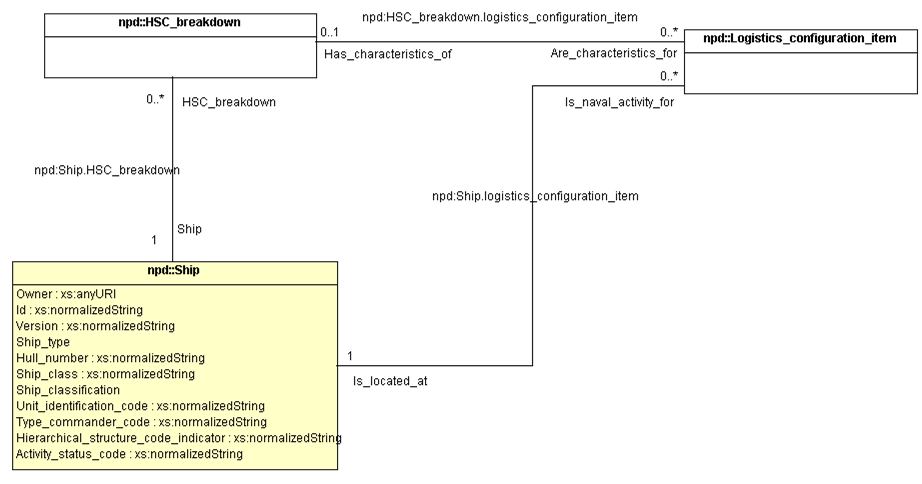
| Business DEX:— Configuration_and_logistics | Date: 2012/10/01 17:45:20 Revision: 1.19 |
The business information requirements are provided within the context of the Navy Product Data Initiative (NPDI) and the Ship Common Information Model (SCIM). The previous figure (Figure 3) provided a UML diagram for the scope of this DEX and the associated information requirements. This section provides more details on each of the information objects.
The Ship (Figure 4) entity represents a ship that operates under the command of the US Navy. It is the primary end product of the design and build activities supported by the IPDE. A ship is uniquely identified by UIC or by Ship Type and Hull Number.
The Ship may have the following types of associations;

The entity npd:Ship represents one particular built hull, which is the primary end product of the design and build activities supported by the NPDI specification. The ship is the primary physical end product of the design and build activities. There is a need for an identifiable entity to represent this end product. The npd:Ship entity is used for each of the many stages of the life cycle of a ship, including new project, concept and detailed design, production engineering, manufacturing, operations, and support. Although the npd:Ship represents a single physical hull, it is typically associated with a class, or range of hulls, that share a substantial proportion of design characteristics. The configuration of all product data defining individual hulls of the class is managed using the npd:Hull_applicability entity in the SCIM. The property Hull_number of the npd:Ship entity corresponds to a single hull in the range of hulls identified in the npd:Hull_applicability properties Start_hull and End_hull. The Ship entity is represented in the Navy Ship Configuration and Logistics Support Information System (SCLSIS) Record Type 1 information. Refer to the SCIM Product Life Cycle Support (PLCS) chapter for further details.
A Ship has the following properties defined;
|
Property Name |
Definition |
Simple-Type |
Use |
Key |
|---|---|---|---|---|
| Owner | Designates the organization and repository that owns the information item. The value should be a URI that uniquely names the repository as well as the organization that owns the repository, in which the information item is managed. | xs:anyURI | required | true |
| Id | Designates the primary identifier of the information item. See Annex A for recommended format of string value. | xs:normalizedString | required | true |
| Version | Designates the version of the information item. | xs:normalizedString | required | true |
| Unit_identification_code | Identifies a unique designator assigned by the Navy or DOD to all organizational units and contractors associated with DOD and related military or federal departments. SCLSIS: Record Type 1, UNIT IDENTIFICATION CODE (UIC). | xs:normalizedString | required | false |
| Activity_status_code | A code to group ships into general status categories. SCLSIS: Record Type 1, SHIP STATUS (STATUS). | npd:Activity_status | required | true |
| Hierarchical_structure_code_indicator | A code used to identify the type of Hierarchical Structure Code (HSC) used aboard a particular ship. SCLSIS: Record Type 1, HIERARCHICAL STRUCTURE CODE INDICATOR (HSCI). | npd:Hierarchical_structure_code | required | false |
| Type_commander_code | Identifies the Type Commander who has Fleet technical responsibility for a specific ship or activity. SCLSIS: Record Type 1, TYPE COMMANDER CODE (TYCOM). | npd:Type_commander | required | false |
| Hull_number | Identifies the individual hull (e.g., 71) for the specific ship against which all configuration and logistics data is recorded. SCLSIS: RECORD TYPE 1, SHIP TYPE AND HULL NUMBER (STHN): [Ship Hull number portion]. | xs:normalizedString | required | false |
| Ship_class | The hull number (e.g., 68) of the ship considered to be the standard for a group of ships within a type built to the same general specifications. SCLSIS: RECORD TYPE 1, SHIP CLASS (CLASS). | xs:normalizedString | required | false |
| Ship_classification | Identifies the ship classification (e.g., Multi-purpose Aircraft Carrier Nuclear-propulsion) for the specific ship against which all configuration and logistics data is recorded. | npd:ShipClassification | required | false |
| Ship_type | Identifies the US Navy Ship type Symbol (e.g., CVN) corresponding to the class type for the specific ship against which all configuration and logistics data is recorded. SCLSIS: RECORD TYPE 1, SHIP TYPE AND HULL NUMBER (STHN): [Ship Type portion]. | npd:ShipType | required | false |
Table 1 — Ship information requirements
NOTE The Simple-Types are generally enumeration lists as documented within the NPDI/SCIM model. As such they form part of the reference data associated with this DEX and are documented within the appropriate section. Other types are dates (mapped to calendar date or date-time plcs representations) or strings (normal/URI).
A Logistics occurrence (Figure 5) is an occurrence of a logistics-worthy item (functionally significant item) for which logistics products and data are developed. Logistics occurrences are often identified by a unique Hierarchical Structure Code (HSC) and related to other logistics occurrences via a logistics occurrence assembly. Logistics occurrence items are the central point for which all logistics support information is developed and maintained. Logistics support information includes equipment configuration, maintenance products, reliability/maintainability/availability data, technical publications, training materials, provisioning and supply support information. Logistics occurrence items are related to the design from which they are based and physical occurrence items representing an installed item on specific ship. The entity npd:Logistics_occurrence is also known as "Hierarchical Structure Code (HSC) item" or "Logistics Configuration Baseline (LCB) item".
The Logistics_occurrence may include the following types of associations;
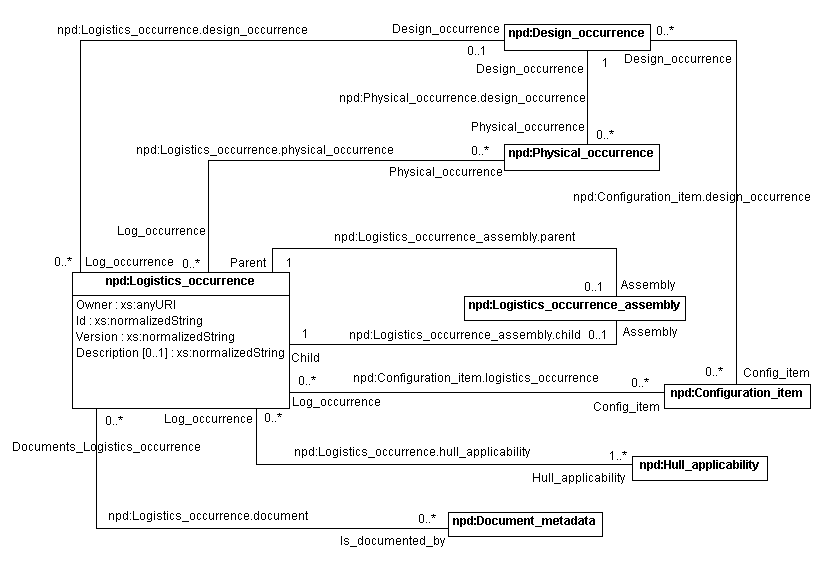
|
Property Name |
Definition |
Simple-Type |
Use |
Key |
|---|---|---|---|---|
| Owner | Designates the organization and repository that owns the information item. The value should be a URI that uniquely names the repository as well as the organization that owns the repository, in which the information item is managed. | xs:anyURI | required | true |
| Id | Designates the primary identifier of the information item. See Annex A for recommended format of string value. | xs:normalizedString | required | true |
| Version | Designates the version of the information item. | xs:normalizedString | required | true |
| Description | Optionally provides additional text that describes the logistics occurrence. | xs:normalizedString | optional | false |
Table 1 — Logistics occurrence information requirements
NOTE The Simple-Types are generally enumeration lists as documented within the NPDI/SCIM model. As such they form part of the reference data associated with this DEX and are documented within the appropriate section. Other types are dates (mapped to calendar date or date-time plcs representations) or strings (normal/URI).
A Logistics configuration item (Figure 6) is a type of Logistics_occurrence that maybe an Installed_item or a Rotatable_pool_item. It represents the occurrence of a physical part on the Ship (or other type of Naval_activity). An occurrence of a physical part at a Naval_activity which is managed and tracked for logistics support and maintenance. A Physical_occurrence item installed on a ship is an Installed_item. A training facility is a Naval_activity with selected systems used for training, including Installed_items at the site. A refit facility has alteration items for refit, referred to as Rotatable_pool_items (RPI), which are pulled from specific ships.
The Logistics_configuration_item may include the following types of associations;
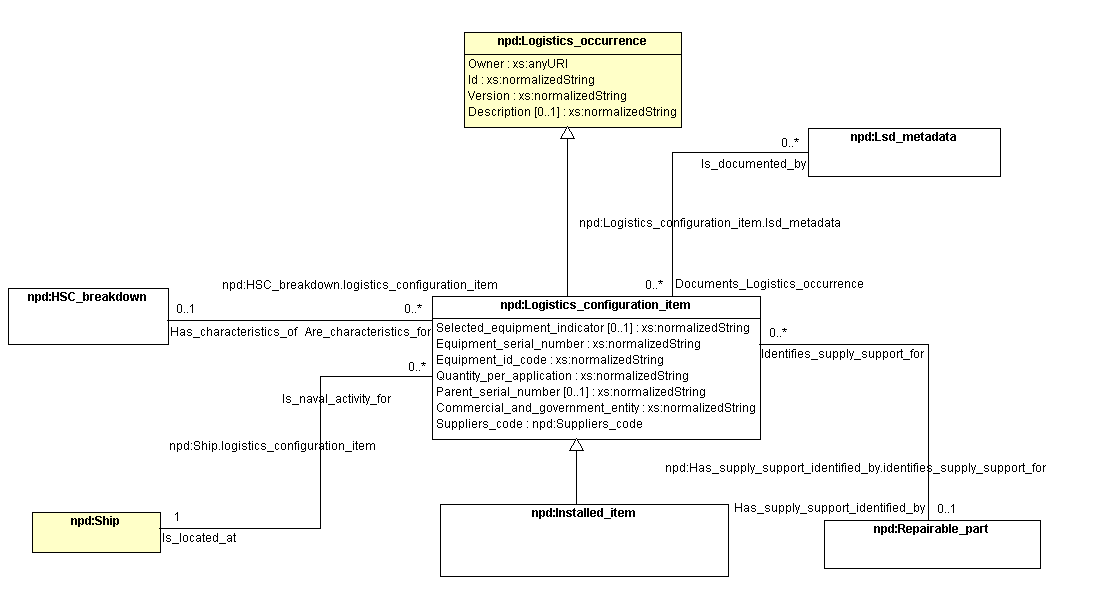
|
Property Name |
Definition |
Simple-Type |
Use |
Key |
|---|---|---|---|---|
| Selected_equipment_indicator | SCLSIS: Record Type 2, SELECTED EQUIPMENT INDICATOR (SEI): Indicates the level of Maintenance Data System (MDS) reporting required by shipboard personnel when maintenance actions are performed on shipboard equipment. | xs:normalizedString | optional | false |
| Equipment_serial_number | SCLSIS: Record Type 2, EQUIPMENT SERIAL NUMBER (SN): Uniquely identifies a specific unit of production within a group of like equipment or components. | xs:normalizedString | required | false |
| Equipment_id_code | SCLSIS: Record Type 2, EQUIPMENT IDENTIFICATION CODE (EIC): Identifies, for maintenance reporting purposes, the functional location, or relative position, of an equipment or assembly within a given system or sub-system hierarchy. | xs:normalizedString | required | false |
| Quantity_per_application | QUANTITY PER APPLICATION (QTY): The quantity of similar items with the identical functional description and that have been grouped under a single hierarchical structure code. | xs:normalizedString | required | false |
| Parent_serial_number | SCLSIS: Record Type 2, PARENT SERIAL NUMBER (PAR SN): Indicates the equipment serial number assigned to the next higher assembly or parent equipment. This field entry assists in identifying parent equipment for use in HSC maintenance. It is primarily used with Electronics and Ordnance data. | xs:normalizedString | optional | false |
| Commercial_and_government_entity | CLSIS: Record Type 2, COMMERCIAL AND GOVERNMENT ENTITY (CAGE): A code assigned to manufacturers of items provided to agencies of the Federal Government. The name designation of "CAGE" replaces "FSCM". | xs:normalizedString | required | false |
| Suppliers_code | SCLSIS: Record Type 2, SUPPLIERS CODE (SC): Designates the source or issuing agency for equipment or components installed in ships or shore activities for new construction, conversion, overhaul, or alteration accomplishment. | npd:Suppliers_code | required | false |
Table 1 — Logistics configuration item information requirements
NOTE The Simple-Types are generally enumeration lists as documented within the NPDI/SCIM model. As such they form part of the reference data associated with this DEX and are documented within the appropriate section. Other types are dates (mapped to calendar date or date-time plcs representations) or strings (normal/URI).
Installed_item (Figure 7) is a type of Logistics configuration item that identifies a Physical_occurrence item installed on a Ship. A Ship configuration baseline in CDMD-OA consists of all Installed_items for a given ship.
The Installed_item may include the following types of associations;
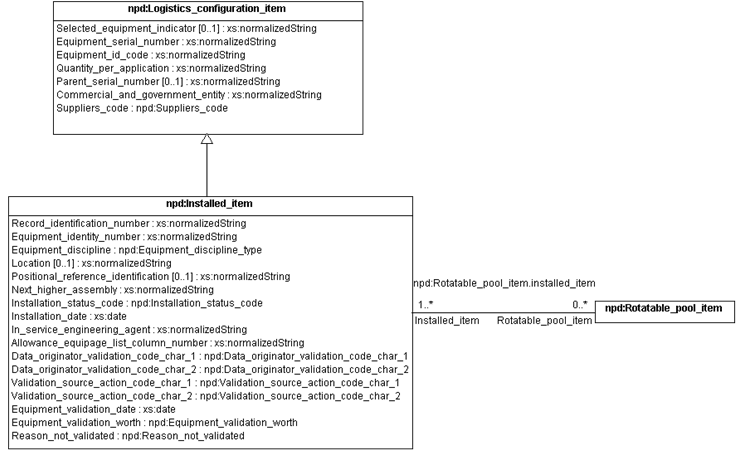
The entity npd:Installed_item provides a means to collect information on a physical item installed on the ship.
For each physical occurrence of a logistics worthy item (see PLCS_Logistics_occurrence), it is necessary to distinguish between items that are physically located on the ship and items that may be located in some other location such as a depot or maintenance facility (see Rotatable_pool_item).
|
Property Name |
Definition |
Simple-Type |
Use |
Key |
|---|---|---|---|---|
| Record_identification_number | SCLSIS: Record Type 2, RECORD IDENTIFICATION NUMBER (RIN): Identifies a record within the WSF/SCLSIS/SNAP/NTCSS databases that contains configuration status accounting and logistics support data. The RIN is basically an address used by these databases for automated retrieval and maintenance of records and data. | xs:normalizedString | required | false |
| Equipment_identity_number | SCLSIS: Record Type 2, EQUIPMENT IDENTITY NUMBER (EIN): Describes Electronics, Ordnance, and NAVAIR ALRE equipment: electronics are designated by the Joint Electronics Type Designation System (JETDS) in MIL-STD-196; ordnance by NAVSEA Manual SWOOO-AD-IDX-010/MK-MOD. Commercial electronics equipment (with no JETDS designation) is identified with manufacturer's model number. For Ordnance, Positions 1-4 = Nomenclature Code, 5-8 = Mark, and 9-12 = Mod. ALRE is identified by NAWC Lakehurst part number. Commercial electronic test equipment is identified with the manufacturer's model number only as designated by NAVSEA ST000-AG-IDX-010 for Test, Measurement and Diagnostics Equipment (TMDE) Index. | xs:normalizedString | required | false |
| Equipment_discipline | SCLSIS: Record Type 2, EQUIPMENT DISCIPLINE (DISC): Identifies the equipment discipline; this will aid in the computation of what percentage of equipment has been sight validated within a specified period of time, aiding in the creation of a Validation Candidate List (VCL). | npd:Equipment_discipline_type | required | false |
| Location | SCLSIS: Record Type 2, LOCATION (LOC): Identifies the shipboard location of an installed equipment or component. Identifies the host equipment or shipboard location of software (installed, backup/recovery and diagnostic). | xs:normalizedString | optional | false |
| Positional_reference_identification | SCLSIS: Record Type 2, POSITIONAL REFERENCE IDENTIFICATION (PRID): A principal entity containing positional reference notation information for Ship/Activity configuration items. PRID data includes software and firmware media type, valve marks, and electrical and electronics symbol numbers identified through other data, including system level schematics and Damage Control Book and Diagrams. Many shipboard items are designated by "numbers" based on their relative position aboard ship or within a system. PRID is a mandatory-one to mandatory-many association with parent SCLSIS/non SCLSIS functional data. Other PRID systems exist or may be established to satisfy unique or special organizational requirements. | xs:normalizedString | optional | false |
| Next_higher_assembly | SCLSIS: Record Type 2, NEXT HIGHER ASSEMBLY (NHA): A coded description of Electronics and Ordnance equipment at the systems level or next higher assembly of the configuration item. Also utilized to identify equipment in which designated software items are installed. Electronics equipment is designated in accordance with the Joint Electronics Type Designation System (JETDS). Ordnance equipment are designated in accordance with the Mark and Mod nomenclature system with the Mark and Mod preceded by a nomenclature code maintained by Naval Weapons Station Concord. Commercial Electronics equipment, to which a JETDS designation is not assigned, is recorded using the manufacturer's model number. No requirements or standardized guidance exist for assigning EINs to Electronics and Ordnance AELs or HME data. | xs:normalizedString | required | false |
| Installation_status_code | SCLSIS: Record Type 2, INSTALLATION STATUS CODE (ISC): Identifies an equipment's installation or removal status. | npd:Installation_status_code | required | false |
| Installation_date | SCLSIS: Record Type 2, INSTALLATION DATE (INSTDATE): Identifies the year and month that the equipment, software or firmware was installed. | xs:date | required | false |
| In_service_engineering_agent | SCLSIS: Record Type 2, IN-SERVICE ENGINEERING AGENT (ISEA): Provides Unit Identification Code (UIC) of the ISEA who has technical responsibility for a specific system or equipment. | xs:normalizedString | required | false |
| Allowance_equipage_list_column_number | SCLSIS: Record Type 2, AEL COLUMN NUMBER (AEL COL): Used to establish which column on an Allowance Equipage List (AEL) is used for a particular ship to determine the allowance quantity of specific equipage items. | xs:normalizedString | required | false |
| Data_originator_validation_code_char_1 | SCLSIS: Record Type 2, DATA ORIGINATOR/VALIDATION CODE (DO/VC): A two-character code that identifies the originator of a record. The first character identifies the generic type of originator. | npd:Data_originator_validation_code_char_1 | required | false |
| Data_originator_validation_code_char_2 | SCLSIS: Record Type 2, DATA ORIGINATOR/VALIDATION CODE (DO/VC): A two-character code that identifies the originator of a record. The first character identifies the generic type of originator. The second character is used by NAVICP MECHANICSBURG to control subsequent parts support/allowance actions. | npd:Data_originator_validation_code_char_2 | required | false |
| Validation_source_action_code_char_1 | SCLSIS: Record Type 2, VALIDATION SOURCE/ACTION CODE (VSAC): A two-character code that identifies the activity that performed the most recent quality review of a record and the level to which it was performed. The first character identifies the activity which performed the review. | npd:Validation_source_action_code_char_1 | required | false |
| Validation_source_action_code_char_2 | SCLSIS: Record Type 2, VALIDATION SOURCE/ACTION CODE (VSAC): A two-character code that identifies the activity that performed the most recent quality review of a record and the level to which it was performed. The second character identifies the level of the review. | npd:Validation_source_action_code_char_2 | required | false |
| Equipment_validation_date | SCLSIS: Record Type 2, EQUIPMENT VALIDATION DATE (VALDATE): Identifies the year, month, and day that the equipment was last sight validated; this aids in the computation of what percentage of equipment has been sight validated within a specified period of time, aiding in the creation of a Validation Candidate List (VCL). | xs:date | required | false |
| Equipment_validation_worth | SCLSIS: Record Type 2, EQUIPMENT VALIDATION WORTH (VALWORTH): Identifies the CDM-assigned validation priority of the equipment; this will support the validation process and aid in the creation of a Validation Candidate List (VCL). | npd:Equipment_validation_worth | required | false |
| Reason_not_validated | SCLSIS: Record Type 2, REASON NOT VALIDATED (RNV): Used in conjunction with the Validation Source/Action Code to specify why an equipment was not fully sight validated. | npd:Reason_not_validated | required | false |
Table 1 — Installed item information requirements
NOTE The Simple-Types are generally enumeration lists as documented within the NPDI/SCIM model. As such they form part of the reference data associated with this DEX and are documented within the appropriate section. Other types are dates (mapped to calendar date or date-time plcs representations) or strings (normal/URI).
Repairable part (Figure 8) is a type of part managed by the US Navy supply system where the part number is specified as a Repairable Identification Code (RIC). A Repairable Part is characterized by a set of physical and logistics properties that may be satisfied by one or more OEM Parts. In addition, if the Repairable Part is an APL or AEL, then it is characterized by a breakdown by quantity of the OEM Parts required for maintenance.
The Repairable_part may include the following types of associations;
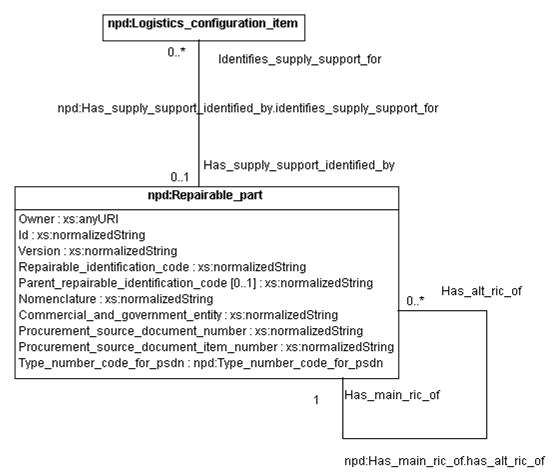
Entity npd:Repairable_part provides a means to collect information on entities managed by the US Navy supply system.
The Navy manages maintenance and supply activities through the use of identifiers known as Repairable Item Codes (RICs). A RIC is a code assigned to uniquely identify a particular commodity. A Repairable_part is identified by a Repairable Item Code (RIC) and is related to the Logistics_occurrence for a piece of equipment.
|
Property Name |
Definition |
Simple-Type |
Use |
Key |
|---|---|---|---|---|
| Repairable_identification_code | SCLSIS: Record Type 2, REPAIRABLE IDENTIFICATION CODE (RIC): Uniquely identifies a particular commodity. When the code is related to an Allowance Parts List or an Allowance Equipage List, it is known as an APL or AEL, respectively. Although the Hierarchical Structure Code (HSC) identifies a function on a ship, the Repairable Identification Code (RIC) identifies the commodity that is performing that function. The RIC relates to a set of characteristics which identify a particular system, equipment, component, or software. For HME data it is the only code available to identify equipment. Electronics and Combat Systems data, while having RICs, have other configuration identifiers: the Joint Electronics Type Designator and Mark/Mod described in MIL-STD-196C and MIL-STD-1661 (05), respectively. | xs:normalizedString | required | false |
| Parent_repairable_identification_code | SCLSIS: Record Type 2, PARENT REPAIRABLE IDENT CODE (PAR RIC): The PAR RIC is the RIC of the equipment or component that carries the supply support for the item, when an equipment or component is not supported by its own APL/AEL, but requires spare parts support. If the equipment or component is not supported by a single, unique RIC, then this field should be left blank. | xs:normalizedString | optional | false |
| Nomenclature | RIC Nomenclature (RICNOM, DEN E001, which is not specified in SCLSIS Specification Part B): Name of the part corresponding to its Repairable Identification Code (RIC). | xs:normalizedString | required | false |
| Commercial_and_government_entity | SCLSIS: Record Type 2, COMMERCIAL AND GOVERNMENT ENTITY (CAGE): A code assigned to manufacturers of items provided to agencies of the Federal Government. The name designation of "CAGE" replaces "FSCM". | xs:normalizedString | required | false |
| Procurement_source_document_number | SCLSIS: Record Type 2, PROCUREMENT SOURCE DOC NUMBER (PSDN): The number assigned to a document under which an equipment or component is being acquired or ordered. | xs:normalizedString | required | false |
| Procurement_source_document_item_number | SCLSIS: Record Type 2, PROCUREMENT SOURCE DOC ITEM NBR (PSDIN): The specific item number on the Procurement Source Document. | xs:normalizedString | required | false |
| Type_number_code_for_psdn | SCLSIS: Record Type 2, TYPE OF NUMBER CODE FOR PSDN (PSDN TNC): A code to indicate the identity or type of document number entered in the Procurement Source Document Number field. | npd:Type_number_code_for_psdn | required | false |
Table 1 — Repairable_part information requirements
NOTE The Simple-Types are generally enumeration lists as documented within the NPDI/SCIM model. As such they form part of the reference data associated with this DEX and are documented within the appropriate section. Other types are dates (mapped to calendar date or date-time plcs representations) or strings (normal/URI).
Logistics_occurrence_assembly (Figure 9) is a type of record that captures the relationship of an assembly to one of its children. The child may be a part logistics occurrence or a sub-assembly logistics occurrence.
The Logistics_occurrence_assembly may include the following types of associations;
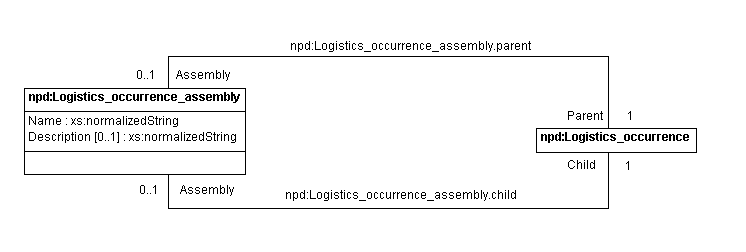
The entity npd:Logistics_occurrence_assembly provides the means to create hierarchical product structures of logistics occurrences within the ship product model.
There are a number of scenarios in the ship support and maintenance life cycle which call for explicit hierarchical assembly structures (product structure views) representing assemblies and the constituents of those assemblies.
A constituent of an assembly may itself also be an assembly (i.e., a subassembly), which in turn is made up of constituents. Logistics occurrences make up the leaves of these hierarchal structures.
An additional requirement is that the product structuring mechanism be loosely coupled to the definition of logistics occurrences so that multiple or various product structures can be assembled over the same set of logistics occurrences.
The entity npd:Logistics_occurrence_assembly is also known as "product structure", "next assembly usage occurrence" or "HSC breakdown".
|
Property Name |
Definition |
Simple-Type |
Use |
Key |
|---|---|---|---|---|
| Name | Provides a general nomenclature for the relationship. | xs:normalizedString | required | false |
| Description | Optionally provides additional text that describes the logistics occurrence assembly. | xs:normalizedString | optional | false |
Table 1 — Logistics occurrence assembly information requirements
NOTE The Simple-Types are generally enumeration lists as documented within the NPDI/SCIM model. As such they form part of the reference data associated with this DEX and are documented within the appropriate section. Other types are dates (mapped to calendar date or date-time plcs representations) or strings (normal/URI).
HSC_breakdown (Hierarchical_structure_code_breakdown)
HSC_breakdown (Hierarchical structure code breakdown) (Figure 10) is a type of Logistics_occurrence_assembly that identifies a breakdown of the ship based on the structural systems that make up the ship (e.g., hull, decks, and bulkheads), and the engineering systems that support the ship's operation and mission (e.g., piping systems, HVAC systems, command and control systems). Each system in the breakdown is identified through the Ship Work Breakdown Structure (SWBS) code, which is defined by NAVSEA Instruction 4790.1B. Systems can be composed of sub-systems. Parts, and connections between the parts, can be classified according to the system that they belong to. Documents, such as System Diagrams, can be related to the System that they represent.
The HSC_breakdown may include the following types of associations;
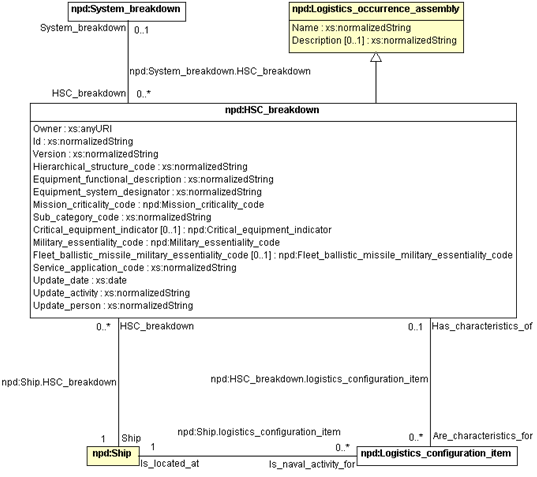
|
Property Name |
Definition |
Simple-Type |
Use |
Key |
|---|---|---|---|---|
| Owner | Designates the organization and repository that owns the information item. The value should be a URI that uniquely names the repository as well as the organization that owns the repository, in which the information item is managed. | xs:anyURI | required | false |
| Id | Designates the primary identifier of the information item. The information item is uniquely identified by the concatenation of all its properties. | xs:normalizedString | required | false |
| Version | Designates the version of the information item. | xs:normalizedString | required | false |
| Hierarchical_structure_code | SCLSIS: Record Type 2, HIERARCHICAL STRUCTURE CODE (HSC): Identifies the functional/hierarchical relationship of the ship, ship system and equipment (to include software and firmware) configuration records. The numbering method may differ in type, but the basic function of this data element is the same. The hierarchical structure establishes the ship to system to subsystem to equipment to component relationships within the ship's data. HSC provides essential data organization that is used for its efficient and effective control, display, and retrieval. | xs:normalizedString | required | false |
| Equipment_functional_description | SCLSIS: Record Type 2, EQUIPMENT FUNCTIONAL DESCRIPTION (EFD): Describes, in shipboard terms, the function performed by a particular equipment or component within a system. | xs:normalizedString | required | false |
| Equipment_system_designator | SCLSIS: Record Type 2, EQUIPMENT SYSTEM DESIGNATOR (ESD): The ESD identifies the principal system or subsystem into which a group of individual components are combined to perform some function. | xs:normalizedString | required | false |
| Mission_criticality_code | SCLSIS: Record Type 2, MISSION CRITICALITY CODE (MCC): Indicates the impact that would result on the mission capability of the ship should a configuration item fail. | npd:Mission_criticality_code | required | false |
| Sub_category_code | SCLSIS: Record Type 2, SUB-CATEGORY CODE (SCAT): SCAT defines the functional requirements category of electronics test and calibration equipment. The first digit of a code used to breakdown the electronic test and calibration equipment into broad functional and mission categories. ALLOWED VALUES: Must be a SCAT value published in the Test, Measurement and Diagnostics Equipment (TMDE) Index ST000-AG-IDX-010 (for test equipment). | xs:normalizedString | required | false |
| Critical_equipment_indicator | SCLSIS: Record Type 2, CRITICAL EQUIPMENT INDICATOR (CEI): Identifies equipment determined to be critical or requiring close monitoring as determined by the SCLSIS process. | npd:Critical_equipment_indicator | optional | false |
| Military_essentiality_code | SCLSIS: Record Type 2, MILITARY ESSENTIALITY CODE (MEC): Indicates the relative military importance of the basic configuration item to the mission of the ship. | npd:Military_essentiality_code | required | false |
| Fleet_ballistic_missile_military_essentiality_code | SCLSIS: Record Type 2, FBM MILITARY ESSENTIALITY CODE (FBM MEC): The greater the numeric value assigned, the more vital the configuration item is to the mission of the ship. An FBM MEC is derived at NAVICP MECHANICSBURG by use of a computer computation module from the system MEC and the equipment or component MEC (FBM MEC couplet); it is then assigned by the preparer of the transaction. | npd:Fleet_ballistic_missile_military_essentiality_code | optional | false |
| Service_application_code | SCLSIS: Record Type 2, SERVICE APPLICATION CODE (SAC): A code used to group equipment, components, assemblies, etc., according to a particular system or service application on board ship. This code is similar to the HSC in purpose, but unlike the HSC, it does not provide a hierarchical structure. | xs:normalizedString | required | false |
| Update_date | SCLSIS: Record Type 2, CONFIGURATION REPORTING DATE (RPTG DATE): Indicates the date when the quality review of a record was performed. | xs:date | required | false |
| Update_activity | SCLSIS: Record Type 2, CONFIGURATION REPORTING ACTIVITY (RPTG ACT): Indicates the activity that last updated the CDMD-OA record. The RPTG ACT is the Unit Identification Code (UIC) of the activity that submitted the update. | xs:normalizedString | required | false |
| Update_person | SCLSIS: Record Type 2, CONFIGURATION REPORTER'S INIT (RPTG ID): Indicates the individual that performed the quality check of a record. The RPTG ID is assigned by each activity to each individual in that activity that submits or reviews SCLSIS transactions. | xs:normalizedString | required | false |
Table 1 — HSC_breakdown information requirements
NOTE The Simple-Types are generally enumeration lists as documented within the NPDI/SCIM model. As such they form part of the reference data associated with this DEX and are documented within the appropriate section. Other types are dates (mapped to calendar date or date-time plcs representations) or strings (normal/URI).
A Design_occurrence (Figure 5) represents the instantiation of a single, location-specific item in the ship design. The Design_occurrence not only represents the design item instance but also provides the means for collecting the properties associated with each design item instance. The properties that apply to a Design_occurrence may vary with respect to the particular type of Design_occurrence (a piping Design_occurrence has different properties from a structural Design_occurrence) or to context (the PDM properties of a Design_occurrence pertain to its configuration management aspect irrespective of design). Its hull applicability characteristics distinguishes a Design_occurrence from a Design_part (which is a design item not associated with any particular hull) as well as from a Physical_occurrence (which denotes one particular item at one particular location on one particular hull).
The A Design_occurrence may include the following types of associations;
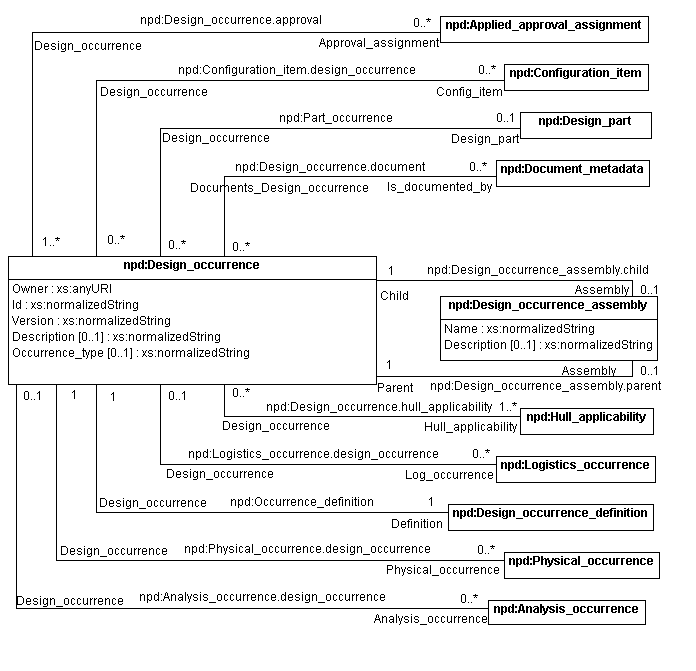
The entity npd:Design_occurrence denotes a significant item in the design product model that may apply to more than one hull.
The design product model for a ship consists of the definition of a number of design significant items. Some of the parts that make up the model are repeated at different locations. However, the ship design must capture and manage information that is unique to the part's location and context in the ship. Thus a Design_occurrence may be an instance of a Design_part that is also used in other locations within the design, or a Design_occurrence may have no such relationship to a Design_part.
While a Design_occurrence may be an instance of a Design_part that is also used in other locations within the design, the use of the same identifier for each instance, with an associated quantity greater than one, is disallowed. While there are aspects of these common parts that are in fact the same for each instance, the nature of a Design_occurrence is that it can be used to collect information specific to its particular location and context. The Design_occurrence is uniquely identified by its Id property.
Another characteristic of US Navy ship design is that the design may apply to a class of hulls. That is, each design will be employed on a number of hulls. Inevitably, there are variations from hull to hull. An item in the ship design needs to be reuseable across more than one hull and assignable to a set of applicable hulls.
Since a ship design is typically built several times and since portions of the design may be changed for some subset of hulls, each Design_occurrence is qualified by its hull applicability, the sequence of hulls to which the Design_occurrence applies. (Note that hull applicability may be associated with a Design_occurrence directly or indirectly through a Configuration_item. In either case, for each Design_occurrence it is possible to determine to which hulls it actually applies.)
|
Property Name |
Definition |
Simple-Type |
Use |
Key |
|---|---|---|---|---|
| Owner | Designates the organization and repository that owns the information item. The value should be a URI that uniquely names the repository as well as the organization that owns the repository, in which the information item is managed. | xs:anyURI | required | true |
| Id | Designates the primary identifier of the information item. See Annex A for recommended format of string value. | xs:normalizedString | required | true |
| Version | Designates the version of the information item. | xs:normalizedString | required | true |
| Description | Optionally provides additional text that describes the logistics occurrence. | xs:normalizedString | optional | false |
| Occurrence_type | Optionally provides the type for the design occurrence. As the parent in a Design_occurrence_assembly, a Design_occurrence may be an item or collection of items of interest. EXAMPLE: A Design_occurrence may be a part, a weld, a planning product structure, a collection of parts in a System, a collection of parts in a Compartment, or a collection of Compartments on a Deck. Subtypes of Design_occurrence in the various chapters of the SCIM provide additional information on some of these types. | xs:normalizedString | optional | false |
Table 1 — Design occurrence information requirements
NOTE The Simple-Types are generally enumeration lists as documented within the NPDI/SCIM model. As such they form part of the reference data associated with this DEX and are documented within the appropriate section. Other types are dates (mapped to calendar date or date-time plcs representations) or strings (normal/URI).
NOTE This object is currently out of scope, but provided here for completeness.
A Design_occurrence_definition (Figure 9) captures the configuration management metadata that pertains to a design occurrence.
The Design_occurrence_definition may include the following types of associations;
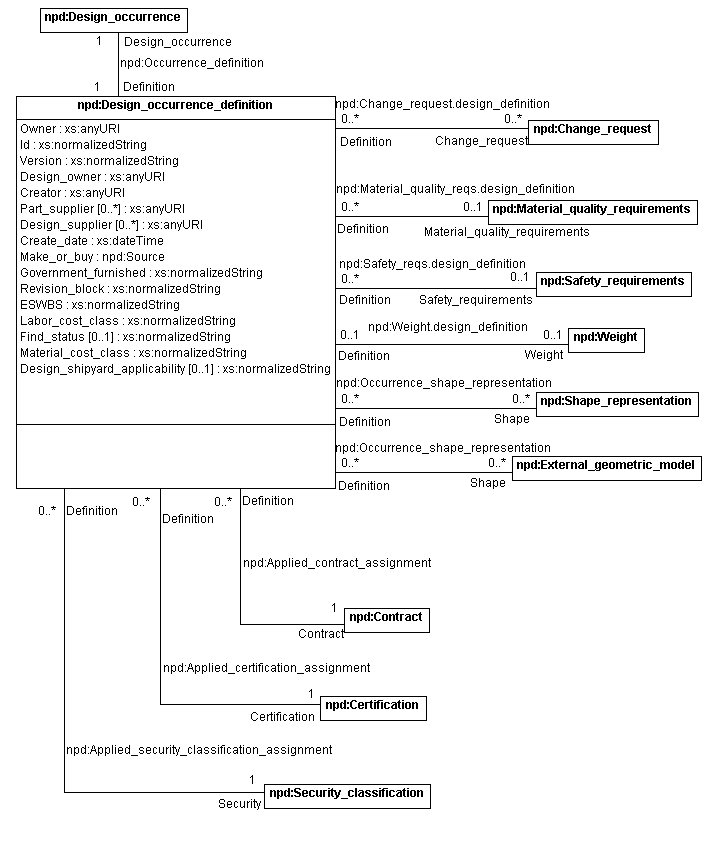
The entity, npd:Design_occurrence_definition provides a means to manage the configuration management metadata for a design occurrence.
In Naval shipbuilding the configuration management of the pertinent design occurrences is a key challenge. Because ships are designed by class and hulls within a class may vary by differing degrees, the configuration management properties of each design occurrence need to be tracked. This includes such matters as creation dates, design authors as well as security, contract, and certification information.
The certification, contract, and security classification data for this design occurrence is provided by means of associations to npd:Certification, npd: Contract, and npd:Security_classification.
|
Property Name |
Definition |
Simple-Type |
Use |
Key |
|---|---|---|---|---|
| Owner | Designates the organization and repository that owns the information item. The value should be a URI that uniquely names the repository as well as the organization that owns the repository, in which the information item is managed. | xs:anyURI | required | true |
| Id | Designates the primary identifier of the information item. See Annex A for recommended format of string value. | xs:normalizedString | required | true |
| Version | Designates the version of the information item. | xs:normalizedString | required | true |
| Design_owner | Designates the person (in organization) who is responsible for the design of this design occurrence | xs:anyURI | required | false |
| Creator | Designates the person (in organization) who originated the design of this design occurrence. | xs:anyURI | required | false |
| Part_supplier | Designates the person or organization that supplies the part. | xs:anyURI | required | false |
| Design_supplier | Designates the person or organization the supplies the design of the design occurrence. | xs:anyURI | required | false |
| Create_date | Designates the date on which the design occurrence was created. | xs:dateTime | required | false |
| Make_or_buy | Designates whether the part for this design occurrence is made or bought. | npd:Source | required | false |
| Government_furnished | Whether the instance is government furnished equipment or not. Valid values are C (Company Provided), G (Government Provided), or B (Government Provided but Company Modified). | xs:normalizedString | required | false |
| Revision_block | User defined revision block, used to establish the Engineering Reports associated with the instance. | xs:normalizedString | required | false |
| ESWBS | Expanded Ship Work Breakdown Structure identification of the service or system in which the Design_occurrence participates. | xs:normalizedString | required | false |
| Labor_cost_class | Accounting classification for the engineering or manufacturing labor associated with the Design_occurrence. | xs:normalizedString | optional | false |
| Material_cost_class | Accounting classification for the material associated with the Design_occurrence. | xs:normalizedString | optional | false |
| Find_status | Find status process code, an occurrence handler which helps decide if the part will go to purchasing or planning. Valid values are F (Final), A (Alternate), O (Optional), M (Furnish with), R (Reference), B (Bulk), I (Information) or E (Estimated quantity, equals F). | xs:normalizedString | optional | false |
| Design_shipyard_applicability | Shipyard applicability. For VIRGINIA, valid values are E (EB) or N (NNS). | xs:normalizedString | optional | false |
Table 1 — Design_occurrence_definition information requirements
NOTE The Simple-Types are generally enumeration lists as documented within the NPDI/SCIM model. As such they form part of the reference data associated with this DEX and are documented within the appropriate section. Other types are dates (mapped to calendar date or date-time plcs representations) or strings (normal/URI).
NOTE This object is currently out of scope, but provided here for completeness.
A Design_occurrence_assembly (Figure 5) captures the relationship of a Design_occurrence_assembly to one of its children. The child may be a part design occurrence or a sub-assembly design occurrence.
The Logistics_occurrence may include the following types of associations;
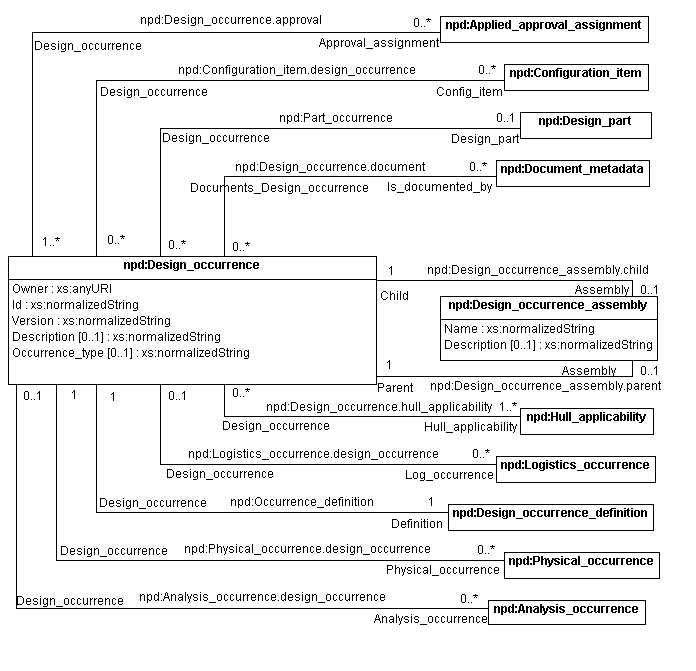
|
Property Name |
Definition |
Simple-Type |
Use |
Key |
|---|---|---|---|---|
| Name | Provides a general nomenclature for the relationship. | xs:normalizedString | required | false |
| Description | Optionally provides additional text that describes information about the design occurrence assembly. | xs:normalizedString | optional | false |
Table 1 — Design_occurrence_assembly information requirements
NOTE The Simple-Types are generally enumeration lists as documented within the NPDI/SCIM model. As such they form part of the reference data associated with this DEX and are documented within the appropriate section. Other types are dates (mapped to calendar date or date-time plcs representations) or strings (normal/URI).
NOTE This object is currently out of scope, but provided here for completeness.
System Breakdown (Figure 14) is a type of Design_occurence_assembly that identifies a breakdown of the ship based on the structural systems that make up the ship (e.g., hull, decks, and bulkheads), and the engineering systems that support the ship's operation and mission (e.g., piping systems, HVAC systems, command and control systems). Each system in the breakdown is identified through the Ship Work Breakdown Structure (SWBS) code, which is defined by NAVSEA Instruction 4790.1B. Systems can be composed of sub-systems. Parts, and connections between the parts, can be classified according to the system that they belong to. Documents, such as System Diagrams, can be related to the System that they represent.
The System_breakdown may include the following types of associations;
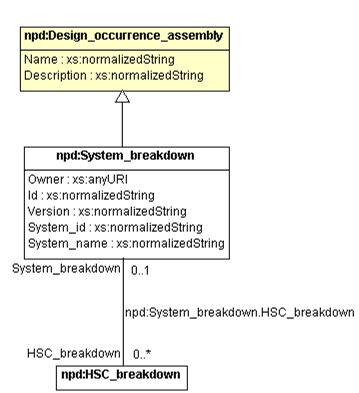
Entity npd:System_breakdown provides a means to collect information on the engineering system breakdown structure.
The system breakdown structure is developed by the engineering group and used during the design the ship.
There is a need to link the Logistics_occurrence items to the applicable design structure in order access design material from which the logistics products are derived and provides a mechanism to identify changes in logistics products based on changes in the design.
Entity npd:System_breakdown is also know as "Expanded Ship Work Breakdown Structure (ESWBS)".
|
Property Name |
Definition |
Simple-Type |
Use |
Key |
|---|---|---|---|---|
| Owner | Designates the organization and repository that owns the information item. The value should be a URI that uniquely names the repository as well as the organization that owns the repository, in which the information item is managed. | xs:anyURI | required | false |
| Id | Designates the primary identifier of the information item. See Annex A for recommended format of string value. | xs:normalizedString | required | false |
| Version | Designates the version of the information item. | xs:normalizedString | required | false |
| System_id | The system identifier using the standard 5 digit ESWBS values. | xs:normalizedString | required | false |
| System_name | The system name corresponding to the system identifier. | xs:normalizedString | required | false |
Table 1 — System_breakdown information requirements
NOTE The Simple-Types are generally enumeration lists as documented within the NPDI/SCIM model. As such they form part of the reference data associated with this DEX and are documented within the appropriate section. Other types are dates (mapped to calendar date or date-time plcs representations) or strings (normal/URI).
NOTE This object is currently out of scope, but provided here for completeness.
The configuration_item (Figure 15) is a key concept to support explicit configuration management. It represents the identification of a particular configuration, i.e. variation of ship design. A configuration_item is defined with respect to the hulls to which it is applicable.
The configuration_item may include the following types of associations;
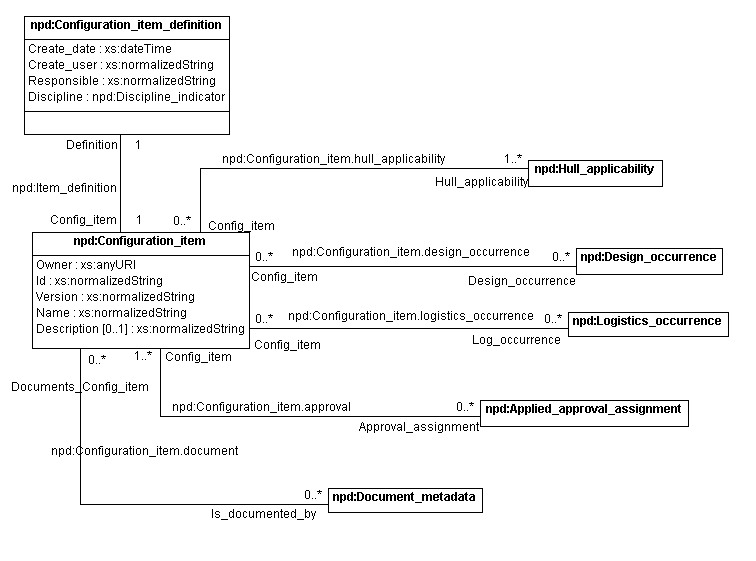
The entity npd:Configuration_item provides a means to collect design occurrences so that they can be configuration controlled as a single group.
The ship product model is a large collection of constantly changing items. Configuration management needs to be applied at a number of different levels.
There is a need for an entity which can collect an arbitrary set of design occurrences and assign hull applicability to that collection as a whole.
Note that any design occurrence in the collection which does not have its own hull applicability inherits the hull applicability of the configuration item.
|
Property Name |
Definition |
Simple-Type |
Use |
Key |
|---|---|---|---|---|
| Owner | Designates the organization and repository that owns the information item. The value should be a URI that uniquely names the repository as well as the organization that owns the repository, in which the information item is managed. | xs:anyURI | required | false |
| Id | Designates the primary identifier of the information item. See Annex A for recommended format of string value. | xs:normalizedString | required | false |
| Version | Designates the version of the information item. | xs:normalizedString | required | false |
| Name | Designates the word or common name used to refer to the configuration_item. | xs:normalizedString | required | false |
| Description | Optionally provides additional information about the configuration_item. | xs:normalizedString | optional | false |
Table 1 — Configuration_item information requirements
NOTE The Simple-Types are generally enumeration lists as documented within the NPDI/SCIM model. As such they form part of the reference data associated with this DEX and are documented within the appropriate section. Other types are dates (mapped to calendar date or date-time plcs representations) or strings (normal/URI).
A Configuration_item_definition (Figure 16) captures the configuration management metadata that pertains to a particular Configuration_item occurrence.
The Configuration_item_definition may include the following types of associations;
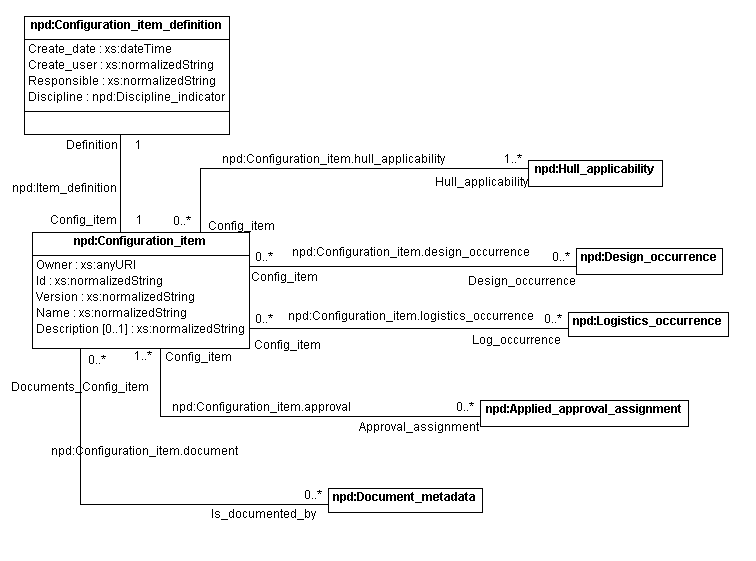
The entity npd:Configuration_item_definition provides configuration management metadata for a Configuration_item.
Configuration management information such as the identification of the product data creator, date of creation, and engineering discipline responsible for the product data are needed, separate from the later management approval of that product data.
|
Property Name |
Definition |
Simple-Type |
Use |
Key |
|---|---|---|---|---|
| Create_date | Designates the date on which the configuration item was created. | xs:dateTime | required | false |
| Create_user | Designates the user who created the configuration item. | xs:normalizedString | required | false |
| Responsible | Designates the designer who is responsible for the configuration item. | xs:normalizedString | required | false |
| Discipline | Designates the discipline of the configuration item. | npd:Discipline_indicator | required | false |
Table 1 — Configuration_item_definition information requirements
NOTE The Simple-Types are generally enumeration lists as documented within the NPDI/SCIM model. As such they form part of the reference data associated with this DEX and are documented within the appropriate section. Other types are dates (mapped to calendar date or date-time plcs representations) or strings (normal/URI).
Hull_applicability (Figure 17) is the identification of a ship hull, or a range of hulls within a class of ships, for which particular product data are applicable.
The Hull_applicability may include the following types of associations;
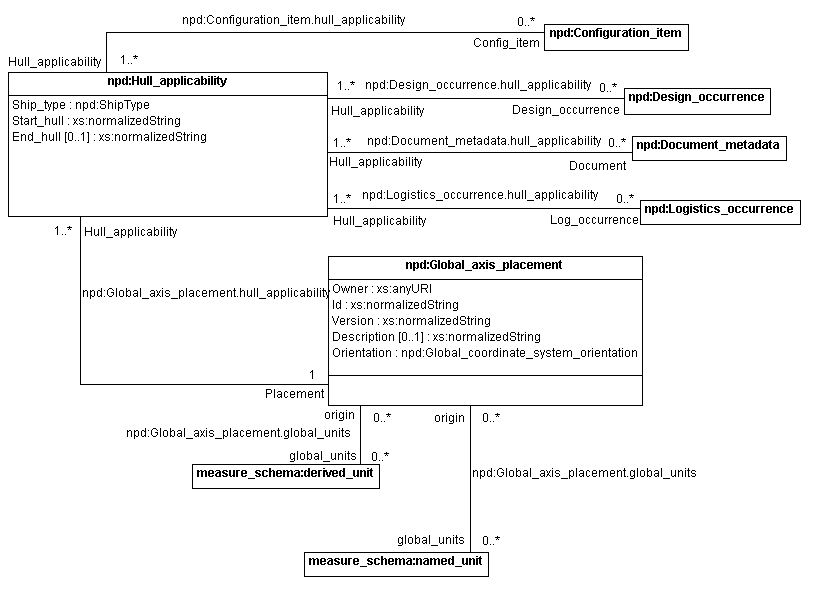
The entity npd:Hull_applicability designates the range of hulls to which a Design_occurrence or other configured item applies.
In the marine industry the concept of hull applicability is extremely important to configuration management.
The hull represents a single ship. Hull_applicability defines the relationship between a Design_occurrence or Configuration_item and one or more hulls.
Using hull applicability, the product model unambiguously designates on which hull or hulls a particular Design_occurrence or Configuration_item is to be used, and which version of that Design_occurrence or Configuration_item is to be used.
For example, hull numbers 701, 702, 703 would be represented with a Start_hull property value of 701 and an End_hull property value of 703.
|
Property Name |
Definition |
Simple-Type |
Use |
Key |
|---|---|---|---|---|
| Start_hull | Specifies the string identifier for the initial hull in a range of hulls for which the product data is applicable. | xs:normalizedString | required | false |
| End_hull | Designates the optional string identifier for the final hull in a range of hulls for which the product data is applicable. If the End_hull value is omitted, the intention is to extend to the last hull in the class (which may not exist at the time). If the Start_hull is the first hull in the class and the End_hull is omitted, the entire class is indicated. | xs:normalizedString | optional | false |
| Ship_type | Identifies the US Navy Ship type Symbol (e.g., CVN) corresponding to the class type for the ship. | npd:ShipType | required | false |
Table 1 — Hull_applicability information requirements
NOTE The Simple-Types are generally enumeration lists as documented within the NPDI/SCIM model. As such they form part of the reference data associated with this DEX and are documented within the appropriate section. Other types are dates (mapped to calendar date or date-time plcs representations) or strings (normal/URI).
A Hull_configuration (Figure 18) versions a collection of logistic_configuration and or design_configuration relationships that are valid for a particular Hull_applicability.
A Hull_configuration may include the following types of associations;
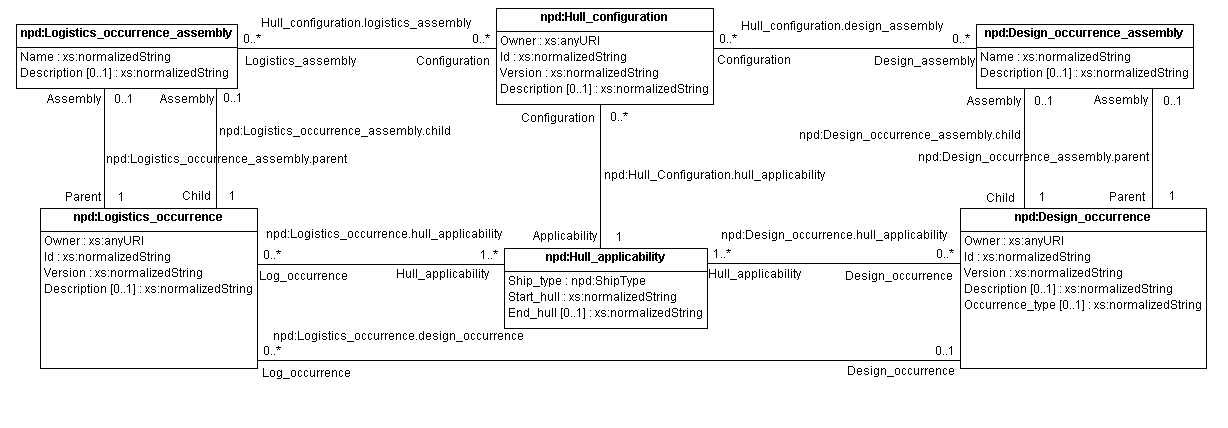
Entity npd:Hull_configuration expanded description to go here.
|
Property Name |
Definition |
Simple-Type |
Use |
Key |
|---|---|---|---|---|
| Owner | Designates the organization and repository that owns the information item. The value should be a URI that uniquely names the repository as well as the organization that owns the repository, in which the information item is managed. | xs:anyURI | required | true |
| Id | Designates the primary identifier of the information item. See Annex A for recommended format of string value. | xs:normalizedString | required | true |
| Version | Designates the version of the information item. | xs:normalizedString | required | true |
| Description | Optionally provides additional information that describes the Hull_configuration. | xs:normalizedString | optional | false |
Table 1 — Hull_configuration information requirements
NOTE The Simple-Types are generally enumeration lists as documented within the NPDI/SCIM model. As such they form part of the reference data associated with this DEX and are documented within the appropriate section. Other types are dates (mapped to calendar date or date-time plcs representations) or strings (normal/URI).
© US DoD 2010 — All rights reserved